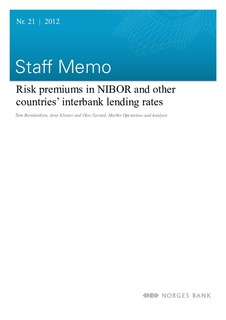| dc.description.abstract | Interbank interest rates such as three‐ and six‐month LIBOR, EURIBOR, STIBOR and NIBOR play an important role as benchmark rates for a number of loan contracts and various types of derivatives. Interbank rates are intended to express the cost of unsecured lending by one bank to another. During the financial crisis in autumn 2008, both NIBOR and other countries’ interbank rates rose markedly in relation to central bank key rates. An extra risk premium in interbank rates reflected higher counterparty risk among banks and reduced willingness to provide liquidity. Since the financial crisis, these risk premiums in interbank rates have fluctuated more and have been considerably higher than prior to the crisis. The risk premium in NIBOR has for long periods been higher than premiums in other countries’ rates. NIBOR has traditionally been derived from the interbank rate for USD and the interest rate differential between NOK and USD from the forward exchange market (forward premium). A characteristic of benchmark rates such as LIBOR, EURIBOR and NIBOR, and the USD rate on which NIBOR quoting is based, is that they are indicative. In the three‐month segment of the unsecured interbank market, which is the most important point of reference, there are very few transactions, not only between Norwegian banks, but also internationally. This raises the question of whether these benchmark rates possess the characteristics a benchmark rate should have, not only with regard to NIBOR, but also to other countries’ benchmark rates. The recent development with Libor manipulation (the Barclays scandal) confirms this. This Staff Memo presents an analysis of developments in NIBOR over the past few years. We show how NIBOR is influenced by developments in the NOK‐USD forward exchange market. A key aspect is how the forward exchange market can dampen the impact of the USD premium on the NOK premium. Equally important is how NIBOR will depend on which USD rate banks apply in their NIBOR quoting. This dollar rate appears to be high compared to the rate the most solid Nordic banks actually pay for short‐term dollar funding. | nb_NO |

